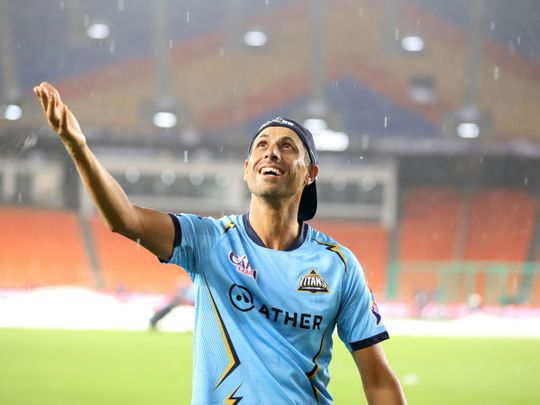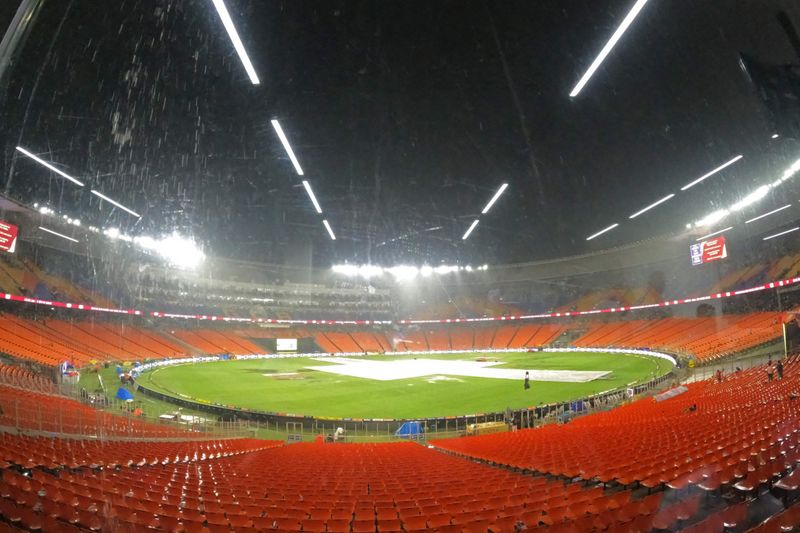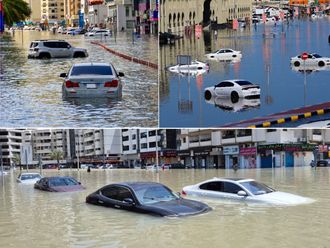
Rain stops play. That’s a perennial damper for cricket enthusiasts. The latest casualty was the IPL 2023 final on Sunday (May 28), which has to be pushed to the reserve day (Monday).
In more than four centuries of cricket, the game has evolved, and so have the facilities. Rain continues to stop play, but the grounds are better placed to be ready to start in less than an hour after the rain stops.
The Narendra Modi Stadium in Motera, Ahmedabad, has a sub-surface drainage system that allows the ground to be ready for play in 30 minutes, the time it takes to drain 75mm of rainwater. That is three times higher than normal.
For play to start in an hour, the rain has to stop completely. That wasn’t the case on Sunday, as persistent showers drenched the stadium and the outfield, although the pitch firmly remained wrapped under the covers.
Motera is not the only stadium to have modern drainage facilities. The M. Chinnaswamy Stadium in Bengaluru has a drainage system that allows the ground to be ready in 15 minutes after the rain stops. The sub-air subsurface aeration and vacuum-powered drainage system clears water 36 times faster than the traditional methods, draining out 10,000 litres a minute. It starts working automatically when it starts raining, according to a report in the Outlook.
Venues like Nagpur, Kolkata, Chennai, Mumbai, Mohali, and Delhi have world-class equipment to protect the pitches and a major part of the outfield from rain.
How ground staff dry the outfield
The outfield in Motera and Bengaluru dry so fast after rains that no additional drying is required. If there are some stubborn damp spots, the super sopper is used to remove the excess water. The super sopper is essentially a roller with absorbent drying rollers.
The pitch and the bowlers’ runup generally remain dry as they are covered with high-quality covers. These areas wouldn’t require much attention other than a bit of rolling.
At venues that lack sophisticated drainage systems, ground staff employ various methods, including air blowers, to remove moisture from the ground. Even hair driers and pedestal fans have been used in places which lacked enough devices to dry the ground. On some occasions, helicopters were deployed to blow away the water particles.
Why a cricket match is stopped during rain?
Umpires allow the matches to continue as long as the rain is light. If the drizzle gets heavier, they stop the game so that the pitch is not exposed to the elements.
A wet pitch can be difficult to bat on as the moisture impacts the character of the surface. Mercifully, that doesn’t happen these days with the availability of high-tech covers that are light and breathe but don’t allow water to seep in.
The outfield takes a beating as it is not covered. Heavy rains make the turf slicker, and fielders are at risk of injury on the slippery surface. One of the Zimbabwean players was injured in a league game in the T20 World Cup in Australia last year, leaving the coach Dave Houghton fuming.

Who has the advantage after rain?
Mediumpacers and bowlers who can swing the ball will love the moisture in the air. So they would be rubbing their hands with glee as it affords lateral movement.
The spinners won’t be too happy. A wet outfield can bloat the ball, making the seam less pronounced. That would affect the spinners’ ability to grip and obtain purchase from the pitch. Even bowlers who revel in bowling cutters wouldn’t be pleased with the lack of a good seam.
Why captains tend to bat first after rain
Seam bowlers may love the conditions, but captains generally prefer to bat in limited-over games after rain. That’s because batters can employ bold strokes, which could throw the bowlers off rhythm.
What teams do if they bowl first
It’s best to start with the most accurate seamers who can bowl outside the off stump and move the ball around. That will prevent batters from hitting across the line, and they could edge deliveries in the haste to get runs.
Bowlers should prevent conceding boundaries so the ball doesn’t roll along the ground long enough to absorb moisture from the outfield and bloat. The lighter the ball, the better it swings.










